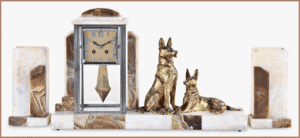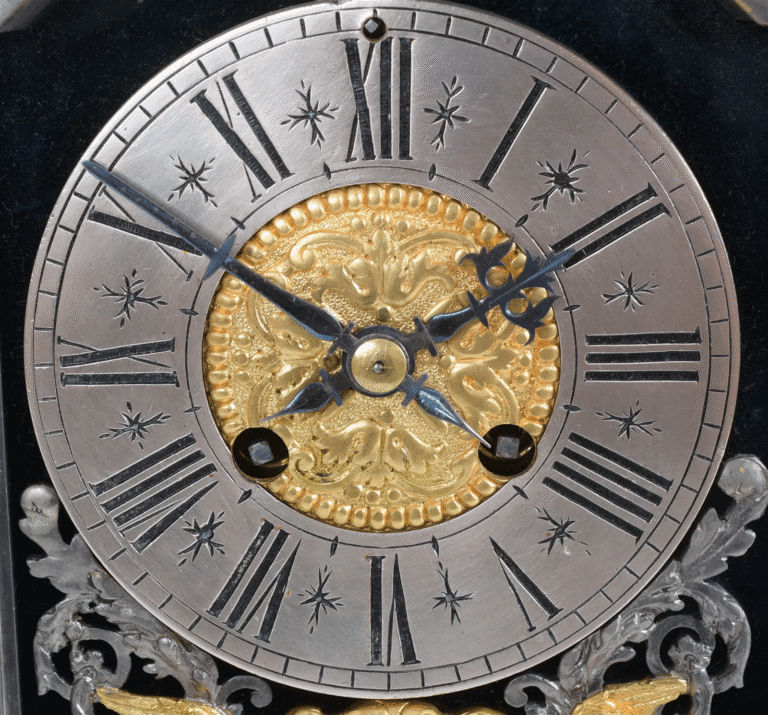There’s a quiet poetry in vintage French clocks, a rhythm so graceful it feels alive. Here, time is told as in the story of life itself—measured not only by minutes, but by beauty, patience, and design. Each clock becomes a stanza in motion, every tick and chime part of a verse written in brass and marble. To live among vintage French clocks is to experience time as art, and to hear, in their gentle heartbeat, the echo of centuries gone by.
When Timekeeping Became French Art
During the 18th and 19th centuries, France led the world in horological artistry. The craftsmanship of vintage French clocks was unparalleled, as clockmakers sought to outdo one another in precision, detail, and decoration. Makers such as Japy Frères, Raingo Frères, and Vincenti turned gears and pendulums into works of art that reflected the refinement of their patrons.

Many vintage French clocks from this era featured gilded bronze, porcelain panels, or marble columns. Even their faces—often hand-painted—spoke of a national pride in beauty and invention. No two were quite alike, which is precisely what collectors cherish today.
Owning or admiring vintage French clocks is not just a nod to the past; it’s an appreciation of what craftsmanship once meant. They combine elegance with endurance—tick by tick, a whisper of history that never quite fades.
Rare Clocks That Define True Distinction
Among collectors, rare clocks hold a particular fascination. These are the elusive masterpieces—unique in design, sometimes experimental in movement—that reveal the ingenuity of French horology, explaining why collectors seek out vintage French clocks more than any other. A vintage French clock in marble and ormolu, topped with mythological figures or delicate cherubs, reflects not just wealth but discernment.
Such rare clocks often come with a traceable lineage. They were gifted between noble families, commissioned by dignitaries, or displayed at the Paris Exposition. When one resurfaces at auction, it’s not simply bought—it’s rediscovered. Every scratch, every mark of patina, becomes a piece of provenance, a small signature from time itself.
The Character Of Vintage French Mantel Clocks
The vintage French mantel clock remains one of the most beloved expressions of 19th-century décor. Designed to command attention from the center of a room, these clocks framed family life—marking dinners, evenings by the fire, and quiet mornings in fading light.
Each vintage French mantel clock reveals a dialogue between sculpture and science. The case might carry allegorical figures—Time, Love, Fortune—while inside, a finely made movement beats with perfect rhythm. Collectors often describe their allure as emotional rather than mechanical. These clocks don’t just run; they breathe.
It’s no surprise that many decorators and collectors now seek vintage French clocks to reintroduce character into modern interiors. Against minimalist surroundings, their warm metal tones and soft tick form a kind of balance—an anchor to a slower, more deliberate world.
The Antique Clock As A Storyteller
An antique clock is a storyteller in metal and glass. Every vintage French clock bears witness to generations who wound it, listened to its chime, and trusted its measure of life’s small moments. To collect one is to inherit those moments—the dinner bell ringing, the soft click before the hour strikes, the steady pulse in an otherwise silent room.
The value of an antique clock isn’t just in its materials or rarity. It lies in its continuity. While technology races forward, these pieces remind us that beauty can still move at the pace of a pendulum swing. When cared for, their movements can last centuries—faithful and precise, even when the hands that first set them have long passed.
Collecting And Preserving The Legacy Of Antique Clocks
For today’s enthusiasts, collecting vintage French clocks is both passion and preservation. The best examples surface through established dealers, estates, or international auctions. Other vintage French clocks are quietly discovered at small antique fairs, still running as they did a hundred years ago.
As demand grows, it’s not unusual to find rare clocks restored with museum-level care, ensuring that each gear and jewel remains authentic. The restoration process itself has become an art—one that respects age while reviving movement. For collectors, owning a perfectly balanced antique clock is a form of stewardship, ensuring these creations continue to live and be admired.
The Antique Clock As Time’s Living Art Form
Whether displayed on a mantel, under a crystal dome, or framed by candlelight, vintage French clocks command attention through quiet authority. Their harmony of design and function captures what the French have always understood—that time, when given beauty, becomes emotion.
Fine vintage French clocks or a one-of-a-kind rare clock isn’t simply an artifact. It’s a small reminder that craftsmanship, once perfected, never loses its voice. The tick you hear today is the same one heard by someone centuries ago—a sound that connects us all to the enduring poetry of time.


